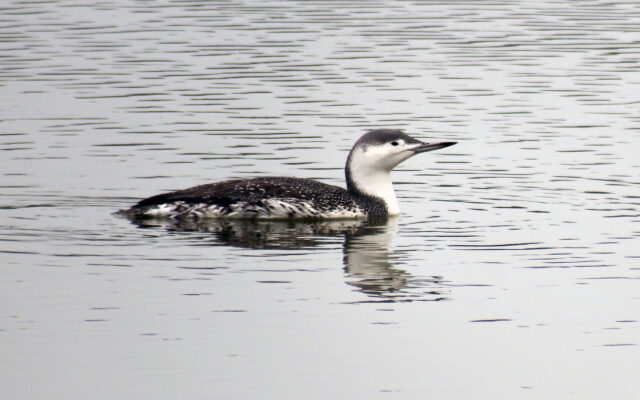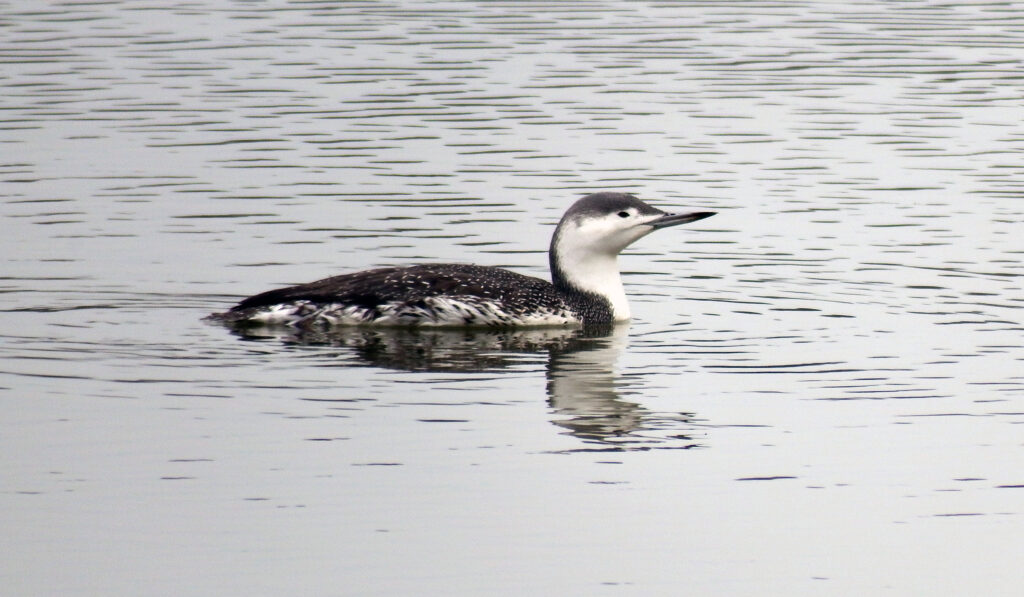
Maine has 2 kinds of eagles and several other pairs of bird species
By Bob Duchesne
We interrupt this column for a special bulletin. I saw the Steller’s sea eagle. The jinx is broken. The curse is lifted. It did not fly away moments before I got there. Many people are still seeing this enormous foreigner at its current stomping grounds in Boothbay.
We now return you to your regularly scheduled column.
Even though the Steller’s sea eagle is far from its home in eastern Russia, it seems to be doing quite well in Maine. It is accustomed to cold weather. It’s feasting on an abundance of food in the Boothbay area, often ducks.

RED-THROATED LOON – The red-throated loon is a winter visitor to Maine and is among several types of birds for which there are two separate species that live in the state.
The eagle is so big, I wonder if it just swallows them whole. It’s not even hunting that hard. The massive bird just bullies the bald eagles, and takes their food. Well, that seems fair. Bald eagles do the same thing to ospreys.
The continuing presence of the Steller’s sea eagle breaks the record for the largest flock of sea eagles ever seen in Maine, which was previously zero. Prior to this, someone could say, “I saw an eagle yesterday,” and everyone would just automatically assume bald eagle.
Alas, for the time being, Maine has two resident eagle species. That got me thinking. How many other pairs of species are there in the state? Let’s think together.
Chickadees. We’re all familiar with the black-capped chickadee. I assume you know there is a second chickadee in Maine, the boreal chickadee, a brown-capped cousin. A couple of years ago, the Legislature considered a bill to decide which was the official Maine state bird, since the statute is vague about that. In its infinite wisdom, the Legislature killed the bill and left it vague.
Grouse. The ruffed grouse is a popular game bird, but there is also the spruce grouse. The spruce grouse and boreal chickadee are both denizens of spruce forests in the North Maine Woods. If you want to see either, you must go to them, because they’re not coming down to see you.
Jays. There are 11 species of jay in the United States. Maine has two of them. Everyone is familiar with the ubiquitous blue jay, and most are familiar with the Canada jay — another northern forest resident. Of all the boreal species, this one may be the easiest to see. They’re bold and tame, and often visit campsites in hopes of stealing a meal. They’re findable just north of Bangor, starting around the County Road in Milford.
Crows. This one surprises people. Maine has two crow species. The American crow is familiar to everyone, but there is also the fish crow. They are nearly identical. I can’t tell them apart by sight, but the difference is obvious by ear. Fish crows have a distinctive voice — a two-syllable uh-uh that sounds like Flipper the Dolphin. They are widespread and abundant south of Maine.
As it happens, Bangor is home to the northernmost colony along the eastern seaboard. There’s a little cluster of them in the neighborhoods around St. Joseph Hospital.
Loons. The common loon is iconic, but Maine is also the wintering ground for red-throated loons. I’d venture a guess that one out of every 20 loons seen along Maine’s coast in January is red-throated. It lacks the red throat in winter plumage, but it is recognizably smaller, with a thinner, often-upturned bill. Everyone knows what a common loon sounds like, but red-throated loons are far from their breeding grounds in northern Canada. They are not wooing mates or defending territories, so they are silent here. I confess that I don’t even know what one sounds like.
Kinglets. Maine has golden-crowned and ruby-crowned kinglets. The former are year-round residents, while the latter are summer nesters that skedaddle south in winter.
Cormorants. Double-crested cormorants are abundant, but most head south in winter. It’s rare enough in January that it is reportable on Rare Bird Alerts. Most of the cormorants seen in winter are great cormorants. They’re about 20 percent larger than double-crested cormorants and adults have white cheek patches. Maine is the southern limit of their nesting range, with a few colonies on offshore islands. They don’t approach the mainland often in summer, but they do in winter.
Crossbills. These nomadic finches have specialized bills that cross at the tip, useful for opening cones. White-winged and red crossbills come and go. Some years they nest here, some years they don’t.
Eagles. At least for now, we’ve got two. Three, if you count the occasional golden eagle. The ducks are getting nervous.